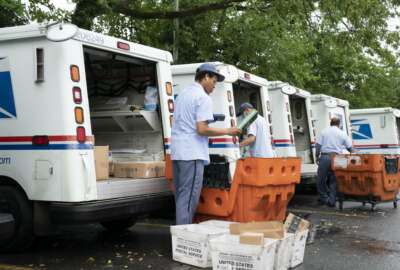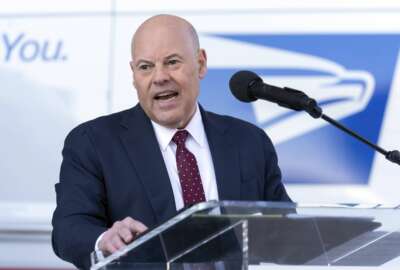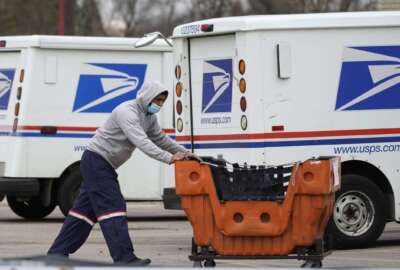
DeJoy says USPS regulator’s network consolidation probe puts financial targets in ‘jeopardy’
Postmaster General Louis DeJoy says Postal Service can still achieve its long-term financial goals – if its regulator and Congress don’t interfere with plan...
Postmaster General Louis DeJoy is telling lawmakers that the Postal Service, facing larger financial losses than expected this year, can still achieve its long-term financial goals — if its regulator and Congress don’t interfere with plans to overhaul its delivery network.
“We need to move, and we can get back on track with this. I see where targets of money are for us to get, just by improving our operational performance and growing our business, but we’re behind. We’re not happy with it,” DeJoy told members of the House Oversight and Accountability Committee on Wednesday.
DeJoy told the government operations subcommittee that USPS still can dig out of a long-term financial hole and break even by 2030, as envisioned in his 10-year Delivering for America reform plan.
But he warned lawmakers that the Postal Regulatory Commission’s scrutiny of the agency’s network consolidation plans “is going to put this whole plan in jeopardy.”
The PRC launched a public-inquiry proceeding in April on USPS plans to bring mail processing and delivery operations under one roof, by creating Sorting and Delivery Centers across the country.
USPS opened its first S&DC in Athens, Georgia in November 2022, and opened another five S&DCs in February.
DeJoy said he expects the agency will have 30 S&DCs running by the end of the year, and 100 by the following year.
The PRC is launching its inquiry to better understand how S&DCs will impact USPS costs and performance.
“The commission finds it beneficial to the interest of transparency to provide a forum to learn more about these strategic plan initiatives that may have a significant impact on the postal community,” the commission wrote.
The commission rejected a broader proposal to review the 10-year reform plan in its entirety.
DeJoy, however, told lawmakers that the PRC has “overstepped their authority” by calling for review of USPS plans to consolidate facilities across its delivery network.
DeJoy told lawmakers that USPS “could move a lot faster,” without the PRC scrutinizing its plans, and blamed the commission for the agency’s financial predicament.
“My hope is our regulator, the Congress gets out of our way, because this is a crisis. We need to move, and taking surveys for every opinion, as our regulator wants to do — and flooding our airwaves with proven methodologies that have not worked in the past — is not helpful,” he said.
The regulator in 2020 gave USPS the authority to set mail prices higher than the rate of inflation.
USPS is making full use of this authority, and has settled into a rhythm of raising rates each January and July. USPS will start charging 66 cents for a first-class stamp this July.
DeJoy, however, said the regulator should have granted this pricing flexibility years ago, and said a “defective pricing” model has been at the root of the agency’s problems for more than a decade.
“The Postal Regulatory Commission sat over and watched the destruction of the organization over the last 15 years, and proactively participated in the destruction of the organization over the last 15 years. What we’re trying to do is save the organization,” DeJoy said. “What goes on, and why they do the things they do, I have yet to figure out — and I’m a pretty smart guy.”
USPS reported a $2.5 billion net loss for the second quarter of fiscal 2023, and expects to see a net loss for the entire fiscal year.
“We are in the process of repairing a 15-year atom bomb that fell on the place. So a quarter or two, in terms of our long-term strategy, is not going to change the infrastructure rehabilitation that we need to do,” DeJoy said.
The agency, he said, has made significant improvements two years into a 10-year reform plan, and has cut its projected losses over the next decade from $160 billion to $70 billion.
USPS estimates about 98% of the U.S. population is getting mail and packages within three days.
DeJoy said USPS, when he took office in 2020, was “in significant jeopardy” and on the verge of running out of cash to operate.
“Nowhere to be found was any comprehensive plan to put the Postal Service on the right track for the future, even though the alarms and bells had been ringing for more than a decade,” he said.
“I want to ensure that we have our eyes wide open about the magnitude of the problem that we need to fix — that we acknowledge the reasons why it is so imperative that we make the kind of significant transformative changes that are outlined in the Delivering for America plan, and that we remain vigilant not to repeat those mistakes of the past,” DeJoy added.
USPS is generally self-funded through its own revenue, but has received financial assistance from Congress in recent years.
Lawmakers gave USPS $10 billion in the CARES Act to withstand the COVID-19 pandemic’s impact on its operations.
The Postal Service Reform Act signed into law last year eliminated about $107 billion in USPS financial obligations, and eliminated a mandate for USPS to prefund health care benefits for postal retirees well into the future.
USPS also received $3 billion in the Inflation Reduction Act to purchase substantially more electric vehicles and charging stations than the agency could otherwise afford. USPS currently expects electric vehicles will make up 75% of its next-generation delivery vehicle fleet.
DeJoy said USPS plans to increase revenue in part by growing its package business, and cutting billions of dollars in annual costs out of its transportation and facilities.
DeJoy said packages make up 60-65% of what USPS moves by volume, “yet we still run the place like we’re moving letters.”
“That’s what we’re trying to redo. I wish I could say it’s ingenious — it’s not. It’s obvious,” he said.
First-class mail, its most profitable product, continues to decline in volume. DeJoy said mail alone can’t bring in enough revenue for USPS to keep operating.
“The delivery of mail is no longer a monopoly, it’s an obligation,” DeJoy said, adding that cost to deliver mail is outpacing revenue. “So we have to get our fair share of the package business, and that’s what we’re trying to do in aligning these things.”
While much of the 10-year plan falls on USPS to implement, DeJoy is calling on the Biden administration to reassess what it contributes to cover postal employees under the Civil Service Retirement System (CSRS).
He’s also calling on Congress to pass legislation that would allow USPS to invest its retirement funds in anything other than low-risk, low-yield Treasury bonds.
A recent report from the USPS inspector general’s office found that if the agency could invest its retirement funds in a portfolio of 60% stocks and 40% bonds, its financial situation would improve dramatically.
“It changes the whole dynamic of what the organization needs to do,” DeJoy said.
House Oversight and Accountability Committee Chairman James Comer (R-Ky.) said DeJoy “is the right person for the job,” and applauded him for coming up with a 10-year reform plan.
Republican lawmakers refused to advance postal reform legislation requested by DeJoy’s predecessor, Megan Brennan, until USPS provided a self-help plan to increase revenue and cut costs.
“You’re the only postmaster general since I’ve been in Congress to even come up with a plan to reform,” Comer said.
Republicans and Democrats on the committee, however, remain wary about USPS meeting its financial targets given declining mail and package volumes. Lawmakers also raised questions about USPS plans to consolidate operations into S&DCs.
DeJoy said his S&DC plans are “going to save service throughout the nation,” and will allow USPS to save billions of dollars on transportation and operations costs.
Meanwhile, USPS and its law enforcement division are stepping up plans to curb mail theft and stop criminals from robbing letter carriers on their routes.
The agency has begun installing 49,000 electronic locks in several cities, and will soon expand this effort to other cities.
USPS also plans to roll out 12,000 high-security blue collection boxes in high-risk areas nationwide through fiscal 2024.
DeJoy said the subcommittee he signed on USPS purchasing new electronic locks and new blue collection boxes a year ago, but said the agency faces supply chain issues to get these products.
“This is a several-year project to tighten up everything the way we need to do it, and it’s not going to be complete without some combined effort on reducing crime in these particular areas,” he said.
More than 400 on-duty letter carriers were robbed in fiscal 2022. USPS said another 300 letter carriers have been robbed on their routes so far in fiscal 2023.
“It’s not one of the things prosecutors run to prosecute,” DeJoy said about a rise in postal crime.
DeJoy said USPS is working with local law enforcement to identify “hotspot areas” where postal employees or boxes have been repeatedly targeted by criminals.
DeJoy however, said USPS’s postal police officers don’t have the authority to protect mail carriers on their routes, and that their jurisdiction only covers USPS facilities.
USPS and the Postal Police Officers Association have been locked in a protracted legal battle for years to determine what jurisdiction postal police officers have beyond USPS facilities.
USPS and the Postal Police Officers Association have been locked in a protracted legal battle for years to determine whether postal police officers have jurisdiction beyond USPS facilities.
DeJoy added that USPS doesn’t have enough postal police officers to patrol USPS routes.
“It’s a big country and we’re a small group. I only have 600,” he said. “If I had 60,000 of them, I would come to you and ask for the authority to do what you’re asking us to do. I don’t. I have 600, and I don’t have the authority to patrol the streets,” DeJoy said.
Copyright © 2024 Federal News Network. All rights reserved. This website is not intended for users located within the European Economic Area.
Jory Heckman is a reporter at Federal News Network covering U.S. Postal Service, IRS, big data and technology issues.
Follow @jheckmanWFED
Related Stories

DeJoy calls for ‘aggressive actions’ at USPS to keep 2030 break-even goal within reach




